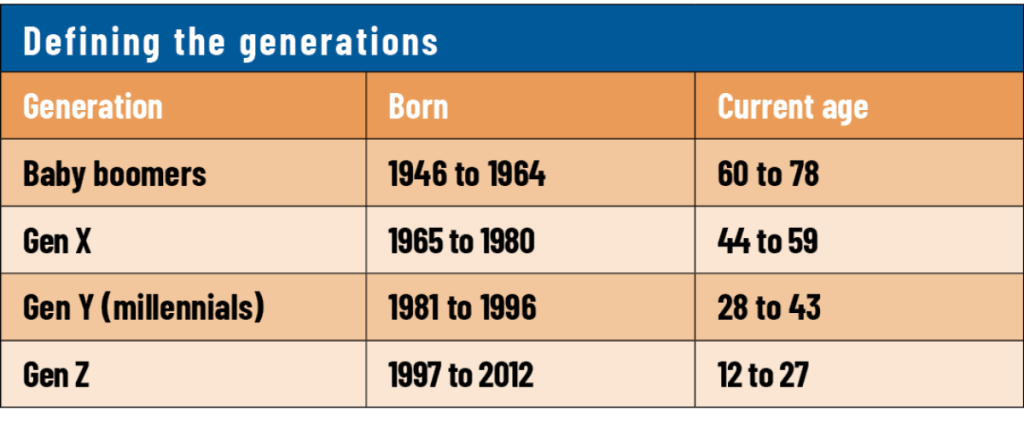
For the first time in history, there are four generations (some say five, if octogenarians of the silent generation are counted) in the workforce. These broadly comprise the baby boomers, gen X, gen Y or millennials, and gen Z.
Many companies would likely have baby boomer or gen X in key leadership positions. The unprecedented age span of the workforce – typically from 22 through 67 years or higher – will need a nuanced leadership, to manage the varied characteristics, values and aspirations of its people.

Multigenerational teams may experience interpersonal tensions in collaboration. The friction may be as fundamental as the interpretation of “hard work” or “commitment” to the use of technology, or the ways people communicate with each other. One way to optimise cooperation and minimise conflict is for leaders to look at the differences as sources of richness and vibrancy to be understood, appreciated and even leveraged, suggests a Harvard Business Review article. So, instead of viewing employees by age-defined “generations”, leaders can look at them as “cultures” which require cross-cultural abilities to navigate. Cultures consider where people are from, as do generations, and they distinguish rather than divide.
Clearly, today’s leaders face a tapestry of challenges like never before, and the issues go far beyond just generational divides. Amid the evolving norms and mega influences ranging from workforce diversity to environmental, social and governance (ESG) compliance, geopolitical crises and other global developments, there is a need to redefine the skills needed for effective, impactful C-suite leadership.
Adaptability and agility are fast becoming the cornerstones of modern leadership, and soft skills are also gaining traction, particularly with trends like remote and hybrid working post-pandemic, says specialist recruitment agency Robert Half.
“Modern leadership calls for skills and experience in strategic thinking, effective communication, and problem solving,” explains Andrea Wong, Managing Director, Robert Half Singapore. “We know workforces are evolving. Technology, globalisation, and artificial intelligence will continue to transform every aspect of our lives, so it’s essential, in a rapidly changing world, that leadership and leadership styles keep pace.”
There are four broad considerations for today’s workplace leadership:
1) Adapting to a diverse workforce
A multigenerational workforce requires an adaptable leader who has various leadership styles. Critically, the leader knows when to switch styles in order to bring out the best in the staff, and optimise collaboration. DEI (diversity, equity and inclusion) is not just a good-to-have or a catchphrase, it has an integral place in the company culture.
2) Modern leadership styles
A leader needs to be transformational in order to inspire people and motivate them towards achieving a collective goal. This style can strengthen relationships among teammates, and help align everyone with the company values. A leader also needs to be situational, with the ability to switch styles and adapt to the needs of the team and the situation at hand.
These leadership styles may encompass elements of democratic, participative leadership, where group discussions, input and decisions are valued; and empathic or servant leadership, which focuses on collaborative teambuilding and harmony.
3) Assimilated into the world
Global issues such as sustainability and human rights are challenging boards and C-suites to modify not only their business processes and operations but also their leadership styles, according to Robert Half. ESG is one example, and its complex management will define executive careers and dominate boardroom thinking in the next decade. Likewise, the EU Taxonomy, which aims to provide clarity on environmentally sustainable activities, will continue to be expanded, with legislation to protect against human rights abuses in supply chains also being phased in. Robert Half Singapore’s Ms Wong underscores the significance of being able to either assimilate into or at least have an understanding of international working environments. “Over 80% of Singapore’s CEOs have international work experience in their leadership career, reflecting the fact that many companies that do business in the region operate across international boundaries.”
4) Developing leadership skills
In this time of extraordinary change, executive leadership needs to adapt and garner the range of skills necessary to guide their companies into the future. Robert Half suggests some ways to do so:
“Everyone in the world knows at least one thing that I don’t.” This axiom indicates that continuous learning is for everybody, including the C-suite. Learning can be informal, such as initiating and engaging in authentic debates and brainstorming sessions with colleagues, or formal, such as attending professional courses and workshops.
Situational leadership creates a psychologically safe environment that encourages innovation as a team. As ideas flow, individuals may have to concede personal “defeat” in favour of the common goal, such as when someone else’s ideas are adopted over theirs.
Give employees the opportunity to take responsibility for projects, as well as for their own professional development. Surveys suggest that gen Y and gen Z, in particular, appreciate the autonomy and trust given to them to lead projects.
Job rotation gives staff exposure to different business areas, and is a powerful professional development tool. It can also help strengthen succession planning and enhance retention and recruitment.
Listen like a leader (LLL), emotional intelligence (EQ), and other social competencies are key to authentic modern leadership styles in the changing world, according to Ms Wong. “Effective leaders today must demonstrate the skills needed to really connect with and nurture staff, and be open to embracing new people, ideas, and leadership and communication styles,” she adds.

While experience used to be the defining characteristic of a good leader, it is the blend of technical/traditional and soft skills that are more essential today. While experience remains important, modern leadership must include a genuine commitment to ESG and DEI. Ultimately, a strong leader is one who can tackle challenges, navigate crises, deliver change, and lead successful teams with confidence, care, and compassion.